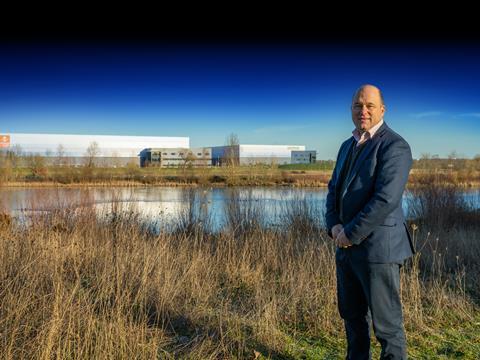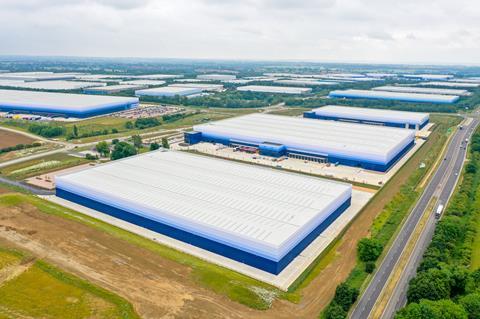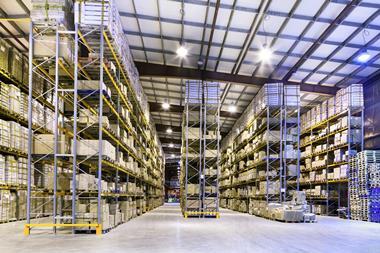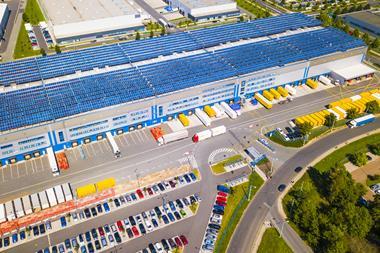The industrial and logistics market might be softening but, as UK managing director of GLP Europe Bruce Topley tells Andrew Saunders, that doesn’t mean it is heading from boom to bust.

It is no secret that the past few years have been a boom time in the warehouse business, and the UK arm of GLP Europe, part of Singapore-based international logistics giant GLP, has been no exception to the rule.
Best known for Magna Park Lutterworth – the largest and oldest dedicated logistics park in Europe – GLP has been growing apace in the UK, with new large-scale Magna Parks at Milton Keynes and Corby under development as well as smaller G Park sites in locations including Skelmersdale, Stevenage and Ashby-de-la-Zouch. The signature graduated blue facades of its warehouses (designed to blend in with the typical British sky and reduce the visual impact of undeniably massive structures) have become an increasingly familiar sight alongside motorways and A-roads alike.
It has been an exciting ride, says Bruce Topley, UK managing director of GLP Europe.
“Five years ago, we [GLP Europe] had about 1.5m sq ft in the UK in ve buildings. Now we have 64 buildings and over 14m sq ft. We’re not the biggest in the business by any means, but that is good growth and we are proud of it.”
It is expansion that has been driven in part by the pandemic-fuelled surge in take-up of warehouse space as e-commerce and online fulfilment become increasingly the norm for retail and wholesale distribution. Savills reported take-up of 50m sq ft and 55m sq ft in 2021 and 2022 respectively, while availability commensurately fell to all-time lows. GLP’s five-year growth spurt has also been facilitated by a change in ownership, adds Topley.
Before the 2017 acquisition by privately held Singapore-based GLP, the business formerly known as Gazeley was a listed UK operation. Since the acquisition, access to global investors through GLP – which has assets of around $120bn (£97bn) in 17 countries across Asia, South America and the US as well as Europe – has provided a ready supply of capital to help keep up with demand.
It has been a similar story across Europe, says Topley. “Growth in the UK reflects how the business has developed in Europe,” he explains.
“Prior to 2017, the business consisted of the UK, France and Germany. Now the business is about five times bigger than it was – we’re in 12 countries and have over £10bn in assets under management across Europe.”
However, the macro outlook for the sector is less rosy than it has been for many years: the UK economy is slowing down, costs are rising and double-digit inflation is hitting consumer demand. Savills’ 2022 European Logistics Outlook survey shows that Q3 take-up dropped 39% year on year in the UK and 41% in France – albeit to levels that are, say researchers, broadly in line with pre-pandemic activity.
Be that as it may, business at Magna Park Lutterworth – GLP’s largest and longest-established UK asset and home to the likes of Amazon, Asda, Iron Mountain and Unipart – continues to be brisk, according to Topley.
“Businesses can only control what we can control. You have to focus on getting the fundamentals right,” he says.

The firm has invested £300m in the site during 2021 and 2022, primarily in building new ‘wings’ on either side of the original central development, with spec development on the smaller Magna Park South site and build-to-suit (BTS) space on Magna Park North.
There is outline permission for 3m sq ft on the southern site (of which 2.2m sq ft has been constructed) and 4.5m sq ft to the north, of which 2.2m sq ft has already been developed. The latter includes a 1.1m sq ft BTS ‘supershed’ for online furniture retailer Wayfair, the largest building on the park to date. Three more huge sites remain, levelled and ready to go, looking for all the world-like pitches waiting to be turfed ahead of a football match between giants.
Despite all the new space being added, Topley says the vacancy rate remains low at around 3.9% and rents remain strong. Moving into a big warehouse is a major investment for occupiers – “in some cases you are looking at capex of £100m on internal fit-out” – so leases are still typically between 15 and 20 years, in marked contrast to the trend for shorter leases in sectors such as high street retail and office space. Of the three most recently completed buildings – speculatively built space on Magna Park South – only one is still awaiting an occupier.
Magna Park Lutterworth itself dates back to 1987, a time not only before ecommerce and onshoring but before widespread use of the internet. It’s the original logistics park, the place that launched 1,000 sheds.
These days the market is much more crowded, of course. “There is undoubtedly more competition in our sector than there ever has been,” says Topley. Will there be a shake-out as demand levels off? “Take-up did come down last year. But if you look at the pre-pandemic averages, we are still way ahead. There will probably be less speculative development due to the capitalisation of some developers.”
Competitive advantage
GLP itself is likely to build proportionately less speculative space and more BTS – Topley expects the balance to flip from approximately 60% speculative development and 40% BTS to 60% BTS and 40% speculative. As an investor and operator as well as a developer, GLP Europe has a competitive advantage when it comes to BTS in particular, he adds, not only in terms of access to capital but also because managing its own assets gives it flexibility and control. “In BTS, the customer needs to trust the developer to deliver on time and on budget, and we have a good track record in that area. We have sites already prepared and we can build quickly to get customers’ products into the market.”
One thing that won’t change, he says, is the firm’s commitment to sustainability. Parent company GLP was an early convert to the need to decarbonise and has produced an annual ESG report since 2013. In the UK, all new warehouses are net zero in construction and maximise natural light to reduce energy costs. The concrete in the slab is low carbon, using blast-furnace slag in place of cement, and many buildings also feature green technologies such as rainwater harvesting and solar panels on the roof.
With only a couple more years before all the consented space at Lutterworth is completed, development will inevitably shift to the firm’s other UK locations. But plans are afoot to create an education hub there, to upskill the next generation of logistics professionals and raise the profile of careers in the sector. Called CLEAR, the £2.5m facility opened in September and the ambition is to find a university partner and develop a national centre of excellence for the industry.
So, the boom years may be over but Topley remains optimistic about the future for Magna Park and for GLP in the UK overall. “It’s only recently that there has been a lot of rental growth,” he says. “Our belief is that the sector is strong and resilient, and it’s proven that over the past 35 years.”
As such, we can expect to see those striking blue facades continuing to proliferate alongside motorways and main roads for the foreseeable future.
GLP in numbers
GLP globally
- $120bn (£97bn) in assets under management
- Operates in 17 countries
- Portfolio covers 51% of the global population and 73% of global GDP
GLP in the UK
- £2.6bn in assets under management
- 14m sq ft of space across 64 units
- 1.6m sq ft of space under construction
- 11m sq ft UK landbank
GLP Magna Park Lutterworth
- 13.6m sq ft of developed space in 46 buildings across three zones: Magna Park Central, Magna Park North and Magna Park South
- Outline permission for a further 16.5m sq ft in total. Completion of Magna Park North and South expected 2024
- First developed in 1987; covers 550 acres including 175 acres of country park and more than one million trees
- Largest and oldest-established dedicated logistics park in Europe
- Home to 33 occupiers
- Provides 12,000 jobs and contributes £500m in gross value added to the economy





























No comments yet